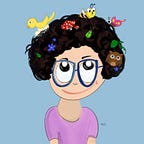Reviving the lost art of reading fiction
When was the last time you bought a fiction? The answer would not be that far in the past if you have a heart for novels. Now, let me ask another question. When was the last time you read a novel — whether it be an emotional family drama, an intriguing crime story or a fantastic sci-fi?
To be specific, when was the last time you read fiction, fully involved in it, reading at your good pace, not being distracted by your phone, its pings and rings? Uhmm… that is a tough one.
I recently began tracking my phone usage. The amount of time I spent on my phone was much more alarming than I assumed I do. The app tells me I unlock my phone more than 50 times a day. That means when I am working, taking a break from work, snacking, or reading — during all this, I am constantly checking my phone… even while writing this article.
It is interesting (and so realistic) how an article about reading fiction has to talk so much about the distractions of phones. Equipped with phone usage apps, focus mode which goes DND and apps like Forest which motivates me to use my phone less, I have been trying to read mindfully.
Reading fiction was my lifeline as a child. I immersed myself in books and was lost in stories. There were days when my mom would shockingly find me unbathed, still wearing my school uniform much late in the night because I couldn’t put down that new storybook, I borrowed from the library.
As a child, I read fiction after fiction without a pause. As I grew up, fiction was replaced with cinema and TV series. Watching content is far more passive than reading fiction. Both involve stories, processing characters’ journeys, progression of plots and so. Yet, when we read, we are the ones visualizing everything, we fill the gap between words with our thoughts and imagination.
As I got lost in the world of bingeing classical movies to contemporary TV shows, jumping from episode to episode, my reading receded. The cupboard has many books marked to read, the google drive is full of pdfs I downloaded to read once or later.
There was also a phase when I would pick up a book to read but it didn’t engage me as such. The constant bingeing in a world of 15 seconds’ content, had killed my patience and ability to take things slow. I grew averse to long descriptions, and slow actions and was looking for things to happen every minute. This kind of content consumption satiety is unable to achieve in reading fiction compared to visual content like cinema. During my moments of reflection while taking a walk or waiting for that unskippable ad to get over, the little girl in me who loved reading reminded me how much I miss it.
That is how I decided to get back to fiction. The first step to reviving the lost art of reading fiction was to find a book which was too good to put down. I knew that if a story was that worth reading, I would do it, no matter what. I chose a novel in my favourite genre of crime thrillers. It was Out (2005), an English translation of the Japanese novel Natsuo Kirino.
Then I didn’t go to another book immediately. I took the time to process and reflect on my reading experience of this fiction. It was a very violent story with a plot that got darker and darker. When I felt I was ready, I picked my next read. This time it was a novel in my mother tongue — Malayalam called Meesha —by S.Hareesh about a lower caste (Pulaya) man who sets out to grow a moustache to the great rage of the upper caste people. So, the second step was to diversify my fiction choices — to read in different languages or translations, about ethnicities, geographies and so.
More than the number of books you read, what matters is how much it moves you. How does fiction move your imagination, emotion and perceptions? Great literature transforms the reader. But it is not the work of the author alone, it is up to the reader to be an active reader. To read and reflect. The third step was to engage with what I read and understood. Sometimes it is illustrating a scene or a character of the novel like the illustration below I did for the Moustache novel.
Sometimes, I write about what I read. It might be in my journal or as an Instagram story. At the least, I think about what I read. Beyond admiring the character constructions and growth, the beauty of metaphors and descriptions, I think about it. I seek examples of similar lives in the world around me, I compare them with my own and I let the fiction realize a bit.
The fourth step was to read what others have written about that fiction. This really brings in a multitude of perspectives as we go through reviews from Goodreads to Instagram to Reddit. A little light lightens up when you read an insight someone else, a total stranger had on the very same book you read. Or a little flash of rage rays up when they make a criticism you would never concur with. The extent of sharing of opinion that the internet facilitates makes reading a social/communal activity not just personal and solitary.
All that said, I don’t do all these steps all the time. I pick and choose, I try to enjoy the process. Another rule I try to follow is not to buy too many new books, If I have many unread ones lying around. So I let myself buy new books only after I have read a few.
So, happy reading! Start reading that fiction you have been wanting to read.
